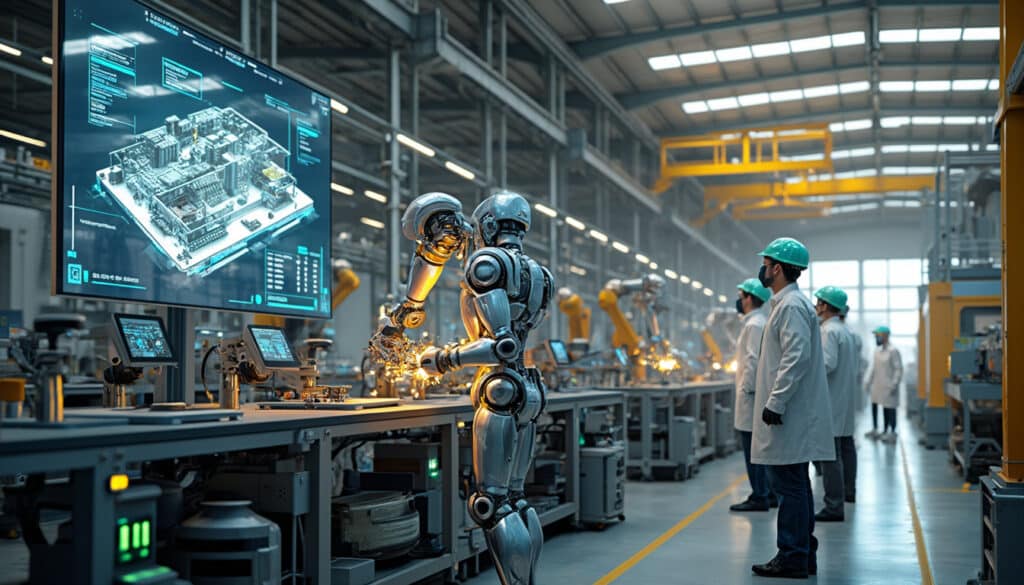The future of manufacturing is undergoing a transformation with the advent of Industry 4.0. Zebra Technologies unveils an innovative framework to support this transformation. At Hannover Messe 2025, this vision will take concrete shape.
The Connected Factory Framework from Zebra Technologies focuses on three essential pillars for business transformation and growth: actionable visibility, optimized quality, and augmented workforce. At Hannover Messe, Zebra presents this framework through demonstrations of advanced technologies such as machine vision, 3D scanning, rugged devices, laptops, communication software for staff, radio frequency identification, and kiosk solutions.
Ryan Martin, Senior Director of Research at ABI Research, emphasizes the importance of a well-aligned strategy: “A finely tuned strategy that synchronizes leadership and resources must be a top priority for decision-makers to achieve connected factories able to capture, analyze, and share real-time insights from frontline workers and machines.” He adds that digital transformation priorities are becoming more pragmatic, with robust deployments of artificial intelligence solutions widening the competitive gap between manufacturers.
The study “The Rise of the Connected Factory” conducted by Zebra reveals that 67% of manufacturing leaders do not know how to begin the process of digital transformation in the workshops. Among the main obstacles are uncertainty about where to start, the availability of resources, and the scalability of projects. Despite this, 89% of companies plan to increase their investments in technology and physical infrastructure by six to ten percent.
Stephan Pottel, Director of Manufacturing Strategy for EMEA at Zebra Technologies, states: “These investment plans are promising and ambitious, but without clear strategic alignment among leaders and an understanding of starting points as well as the resources needed to scale projects, there is a risk of wasted budgets and poor execution. The Connected Factory Framework can provide the necessary assistance.”
To learn more about event updates, visit our dedicated page.
The manufacturing industry is undergoing transformation with the advent of Industry 4.0. At Hannover Messe 2025, Zebra Technologies presented a new connected factory framework, designed to assist manufacturing leaders in their digitalization projects. This innovative framework is based on three essential pillars that promise to transform industrial processes and stimulate growth.
Table des matières
ToggleWhat are the key pillars of Zebra Technologies’ new Industry 4.0 framework?
The Connected Factory Framework from Zebra Technologies revolves around three fundamental pillars: actionable visibility, optimized quality, and an augmented workforce. These pillars are designed to address the current challenges of the manufacturing industry and prepare companies for effective digital transformation.
Actionable visibility
Actionable visibility allows companies to capture, analyze, and share real-time data from machines and frontline workers. This increased transparency facilitates quick and informed decision-making, which is essential in a dynamic production environment. Through technologies such as machine vision and 3D scanning, businesses can continuously monitor operations and immediately identify anomalies or improvement opportunities.
Optimized quality
Optimizing quality is crucial to maintaining competitiveness in the market. Zebra Technologies offers advanced solutions such as rugged devices and communication software for the workforce, which ensure rigorous and regular quality inspection. The use of artificial intelligence (AI) in manufacturing processes not only allows for more efficient defect detection but also continuously improves production standards.
Augmented workforce
An augmented workforce powered by technology is at the core of digital transformation. Laptops and portable devices, advanced communication software, and radio frequency identification (RFID) solutions enable workers to collaborate more effectively and easily access the information they need. This increase in productivity and efficiency directly contributes to the resilience of supply chains and the intelligence of automation.
How does Zebra Technologies integrate its solutions at Hannover Messe?
At Hannover Messe 2025, Zebra Technologies showcased its connected factory framework through a series of practical demonstrations. Technologies such as machine vision, 3D scanning, rugged devices, and portable laptops were highlighted to illustrate how they can be integrated into manufacturing processes. Additionally, workforce communication software and radio frequency identification systems were presented, demonstrating how they can enhance resource management and product traceability.
What is the impact of this framework on the digital transformation of manufacturing companies?
According to a study conducted by Zebra Technologies, titled The Rise of the Connected Factory, 67% of manufacturing leaders do not know how to start their digital transformation. The main identified obstacles include uncertainty about the starting point, the availability of resources, and the scalability of projects. Zebra Technologies’ connected factory framework directly addresses these challenges by offering a clear and structured roadmap for digitalization.
Ryan Martin, Senior Director of Research at ABI Research, emphasizes the importance of a well-aligned strategy between management and resources. “A finely tuned strategy that aligns management and resources must be a top priority for decision-makers to achieve connected factories that seamlessly capture, analyze, and share real-time data insights from frontline workers and machines.” He adds that digital transformation priorities are becoming more practical with the robust deployment of AI solutions, thereby widening the competitive gap among manufacturers.
What are the investment prospects in Industry 4.0?
Despite the obstacles, 89% of companies planned to increase their technology and physical infrastructure investments by 6% to 10% by 2030. Stephan Pottel, Director of Manufacturing Strategy EMEA at Zebra Technologies, describes these ambitious plans as promising. “These investment plans are promising and ambitious, but without clear strategic alignment across management and understanding how and where to start, as well as managing resources and scalability of projects, there may be a risk of wasted budgets and poor execution. The connected factory framework can help.”
How does Zebra Technologies’ framework address the specific needs of manufacturing leaders?
The framework proposed by Zebra Technologies is designed to be adaptable and scalable, thereby meeting the varied needs of manufacturing companies. By integrating solutions such as machine vision, 3D scanning, and wearable devices, businesses can customize their approach to digitalization based on their operational specifics. Additionally, advanced software solutions facilitate communication and collaboration, which are essential for successful transformation. To learn more about innovative technologies at the forefront, check out this article on the revolution of Industry 4.0.
What is the importance of strategic alignment in the implementation of the framework?
Strategic alignment is crucial to ensure that digitalization initiatives are coherent and effective. Without a clear vision and commitment from management, projects can quickly derail, resulting in unnecessary expenditures and disappointing outcomes. Zebra Technologies emphasizes the need for a well-defined strategy that not only identifies priorities but also allocates adequate resources for each step of the transformation process. This systematic approach ensures a successful and sustainable implementation of Industry 4.0 technologies.
What are the tangible benefits of adopting the Industry 4.0 framework?
Adopting Zebra Technologies’ Industry 4.0 framework offers numerous tangible benefits to manufacturing companies. Among them, there is a significant improvement in productivity due to better visibility of operations and an optimization of product quality. Furthermore, the augmented workforce through technology reduces human errors and enhances employee satisfaction by providing them with more efficient and intuitive tools.
By investing in advanced technologies such as AI and IoT, companies can also strengthen their resilience against supply chain disruptions. For an in-depth analysis of the Industry 4.0 market, discover this market study that reveals promising prospects.
What is the response of experts to this new initiative?
Industry experts are positively welcoming Zebra Technologies’ new framework. Ryan Martin from ABI Research appreciates the strategic clarity that the framework offers, stating that “the priorities of digital transformation are becoming more practical, with robust deployments of AI solutions widening the competitive gap among manufacturers.” This perspective is shared by many industry players who see in this framework an opportunity to effectively structure their transition to Industry 4.0.
Additionally, the demonstrations carried out at Hannover Messe allowed participants to concretely visualize the practical applications of the framework, thereby reinforcing manufacturing leaders’ confidence in their ability to effectively implement these technologies. To learn more about innovative applications in Industry 4.0, check out the article on Nokia’s new applications.
How does Zebra Technologies plan to support businesses post-Hannover Messe?
After Hannover Messe 2025, Zebra Technologies continues to support businesses on their digitalization journey by offering additional resources and ongoing support. The connected factory framework is accompanied by training, personalized consultations, and technology updates to ensure that companies remain at the forefront of innovation. To deepen your understanding of Industry 4.0, explore the resources available at this link.
By integrating this framework, manufacturing leaders can not only overcome the initial challenges of digital transformation but also fully leverage the opportunities offered by Industry 4.0 to position themselves advantageously in an ever-evolving global market.





